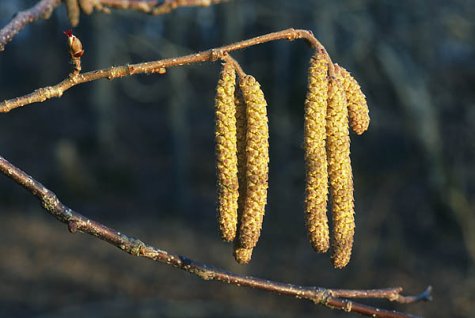Week 16: weather survey
Compiled by Ele Pedassaar
Photo: Arne Ader
Translation: Liis
Hazel flowering.
In the beginning of the week (19.04) there were heavy showers in several places in Estonia (in places also hail), following a low-pressure area moving towards northern Russia, and the westerly and north-westerly wind that also brought colder air, was strongest on the northern coast: up to 14 m/s. Towards the evening a high pressure ridge stretched over Estonia, clearing the sky from clouds and bringing the night temperature on Tuesday (20.04) night mostly below zero: the minimum of the week was recorded from Kuusiku: -5,1 °C.
On Wednesday (21.04) a new low pressure area moved from the southern part of Scandinavia towards north-east. In front of it the southerly and south-easterly winds became stronger, 12 m/s, and the heavier rain that had reached the islands spread to the mainland in the afternoon.
On Thursday-Friday (22.-23.04) a depression moved across southern Finland and Karelia towards northern Russia, where it stopped up. In Estonia rainfalls alternated with brighter intervals. Since colder air arrived in Estonia along the western edge of the low pressure area, the rain was on many places replaced with snow slush on Friday night. In daytime a high pressure ridge dispelled the clouds for a brief time but a new low pressure area approached from the west together with colder rain and snow, which on Saturday (24.04) night in some places even left a slight cover of snow on the ground.
On Saturday (24.04) the trough with accompanying precipitation retired during the day towards east and from the southern part of the Baltic a high pressure area with dry air approached. The westerly and north-westerly wind grew in force between the two pressure areas to 9-13 m/s, in gusts to 16-18 m/s.
On Sunday (25.04) the weather cleared up, but at the edge of a high pressure area over Latvia and Lithuania and moving towards east a strong westerly wind persisted (gusts up to 16 m/s). The sun showed its power that day, raising the air temperature in central Estonia in Türi to 13,9 °C(maximum of the week.
After eliminating the extremes, the air temperature inland fell to some degrees below zero at nights, on the coast some degrees above zero. In daytime it was about +5 - 12 °C, in cloudier and rainier periods the air temperature stayed between 2°C and 8 °C.
Water bodies were warming up. In Estonian coastal waters ice was to be found only in the central parts of the Gulf of Riga (the thickness of the packed ice was up to 10-25 cm). Lake Peipus was wholly free of ice. Temperature in inland waters had risen to 4 to 7°C towards the end of the week.









